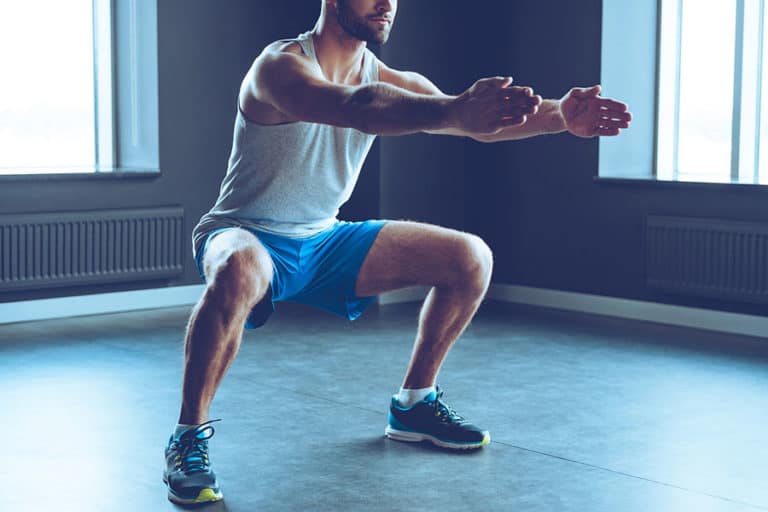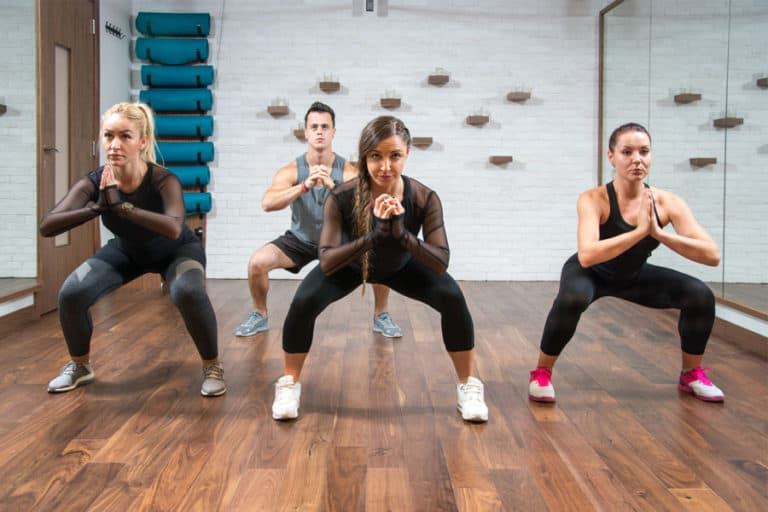Front Squats – How to do, Variations, And Safety Tips

How to do | Muscles worked | Who Should/Should Not | Add to routine | Safety Tips | Benefits | Variations
Front squats, also known as barbell front squats, are anterior loaded squats that use a barbell held across the front of the shoulders.
It is an advanced variation of squats that offers a few distinct advantages.
It is a spine-friendly exercise that allows a more thoracic extension.
It is a great supplemental exercise for those who want to improve their performance in other lifts, such as the back squat, clean, and jerk.
How to do front squats?
It is imperative to perform front squats with proper form and technique to reap the benefits and avoid injury.
Follow the steps below to execute front squats properly:
- Start with your feet shoulder-width apart and the barbell positioned on the squat rack across the front of you, nearly at the height of your collarbone.
- Lift your elbows forward and away from your body in a way that your upper arms get parallel to the floor.
- Grasp the barbell off the J-hooks of the rack by wrapping your thumb and index finger around the bar.
- Move your body forward to ensure your shoulders are directly under the bar, and the barbell rests on the upper part of your chest across the front deltoids.
- Unrack the barbell and take a step back. This is the front-rack position.
- Slightly widen the distance between your feet and point your toes outwards.
- Keep your torso upright, chest out (puffed up), and stand tall.
- With your core engaged and weight balanced on your heels, lower your hips into a deep squat position.
- Your elbows should remain lifted throughout the move. This will prevent the barbell from rolling forward.
- Once you are at the bottom position of the squat, pause for a moment.
- Extend your hips and knees simultaneously as you move back into the starting position.
- Perform the entire movement steadily and consciously.
- Once you are done with the required number of sets, re-rack the bar safely without changing your elbow position.
Note: If you have challenges with wrist mobility,you may use two or more fingers of your hands. This ensures a better grip and avoids extra stress on the wrists while performing the front squat.
Muscles worked
The front squat is a great compound exercise [1]American Council on Exercise: 5 Benefits of Compound Exercises for the entire body – upper body (torso and lower back) and lower body (legs). It works several muscles and joints at the same time.
Primary muscles worked:
| Quadriceps | rectus femoris, vastus lateralis, vastus medialis, vastus intermedius |
| Hamstrings | the biceps femoris, the semitendinosus, and the semimembranosus |
| Inner calf muscles | soleus |
Secondary muscles worked:
| Core muscles | transversus abdominis, rectus abdominis, external obliques |
| Glutes | gluteus maximus, gluteus medius, gluteus minimus |
| Back muscles | trapezius, rhomboids, latissimus dorsi, erector spinae |
| Joints engaged | wrists, knees, and ankles |
Who should and should not do front squats?
The front squat is an advanced level squat and is considered safe when the necessary precautions are taken. Hence, there are certain individuals who should avoid this exercise.
However, this move is also loaded with its unique benefits and should be included by certain sets of people.
You should do this, if:
- You are interested in enhancing your quad strength and hypertrophy. Unlike back squats, the front squat is a front-loaded squat. Hence, it shifts more of the weight to the muscles in the front of your thighs (quads) instead of the muscles at the back of your thighs (hamstrings). Thus, it works the quads and enhances their size and strength.
- You are a sports athlete and aim to have good lower body strength to perform explosive exercises (jumping, running) and lifting weights [2]ResearchGate: Exploring the Front Squat while performing other advanced squats.
You should not do this, if:
- You have some pre-existing injuries or conditions. You must perform the exercise under the care of a certified fitness trainer or a physiotherapist.
- People who have undergone recent knee, shoulder, or elbow surgery must avoid this exercise.
- Individuals suffering from lower back pain/issues must avoid performing this exercise. However, front squats are easier on the back as compared to back squats. As they produce less compressive forces [3]PubMed: A biomechanical comparison of back and front squats in healthy trained individuals than the back squat, they are easier on people with back issues.
- Older adults and beginners must start with basic squats and then move on to the front squat.
Adding it to your routine
Understanding how to program the front squat into your workout routine is essential.
Here is a sample circuit and some important notes for your reference:
Beginner level
2-3 sets of 5-8 reps of the barbell front squat without weights to enhance and correct their squat form.
Intermediate level
2-4 sets of 15-20 reps with moderate weights to develop muscular endurance to slowly accustomed the body to heavier lifts.
Advanced level
4-6 sets of 1-5 reps for strength building and 3- 6 sets of 5-12 reps for muscle building with heavy weights.
Notes: The front squat can be performed 2-3 times per week.
Safety tips
Safety is one of the primary concerns when performing any exercise. Hence, it is important to take some safety precautions before you start your set.
Warm-up
As with any other exercise, it is important to warm up before performing the front squat. A few minutes of light cardio followed by some dynamic stretching is ideal.
Use a safety bar
You may place a safety bar on the rack in case your legs are fatigued and unable to lift the weights at the end of your set. It should be placed at the lowest level of your squat.
Use a weightlifting belt
A weightlifting belt provides support to your back and helps you maintain a neutral spine position during the exercise.
Use proper form
- Use your fingers to prevent the bar from rolling out when performing the front squat.
- Keep your elbows parallel to the floor. If your elbows drop, the weight may roll off and cause injury.
- Ensure you do not arch your back and maintain an upright torso throughout the move.
- One of the most common mistakes is to let your knees cave in. Your knees should be inline with your torso.
- It is essential to squat deep with a neutral spine for full benefits. Partial squats would not be beneficial in this case.
- Heels should be firmly planted on the ground. If you move your weight onto your toes, you may lose balance and topple forward.
- You are recommended to wear flat-soled shoes while squatting for maximum balance.
- Breathe in as you squat down, and breathe out forcefully as you come back up.
Use a spotter
It is best to perform the exercise under the supervision of a spotter as they can help correct your squat form and also help you safely rack your weights.
Benefits of front squats
The front squat may seem challenging at the beginning. Nonetheless, once you adapt to its intensity, this exercise offers a number of benefits, as listed below:
- The front squat is a functional movement that can help in activities such as picking up heavy objects from the floor. They help improve mobility, flexibility, and range of motion. They have the ability to open up your hips. Thus improving your range of motion and eventually making you more flexible than when you started.
- Compared to back squats, front squats place less stress on the lower back [4]PubMed: A preliminary comparison of front and back squat exercises and spine. This makes it a relatively good option for people with back pain or injuries.
- Front squats can help improve explosive power as they train the muscles used in jumping.
- This exercise can also help prevent knee injuries. Moreover, the secondary muscles activated in the move (lats, trapezius, deltoids, pecs, and serratus anterior) help stabilize your upper body and enhance your core strength.
- Studies [5]Bridgewater State University: Lower Body Kinematic Comparisons between front and back squats in response to loads show that front squats are easier on the knees than back squats. It puts significantly less compressive force, which makes it advantageous for people with knee problems.
Front squat variations to try
Front squats can be modified as per your level of fitness and needs. You can increase or decrease the intensity of this exercise by adjusting the squat’s weight, tempo, and range of motion.
Here are some front squat variations of front squats are:
1. Zercher squats
This variation of the front squat involves placing the barbell in the crook of your elbows, known as the Zercher position. This exercise is more challenging than the traditional front squat and helps build strength in the upper back and biceps.
2. Double kettlebell front squat
This squat is an alternative to the front squat if barbells are unavailable. The double kettlebell front squat is a challenging variation of the goblet squat (single kettlebell). This squat involves holding two kettlebells in the rack position. This move helps improve grip strength and core muscles.
3. Box squat
Box squat requires you to place a box or a bench behind you before performing the squat. This variation works well for individuals with difficulty lowering themselves to full squat depth.
Conclusion
The front squat is an excellent exercise for overall lower body development. It is especially effective for developing the quads, hamstrings, and glutes. When performed correctly, it can also help improve ankle mobility and range of motion and enhances your Olympic lift techniques.
References
| ↑1 | American Council on Exercise: 5 Benefits of Compound Exercises |
|---|---|
| ↑2 | ResearchGate: Exploring the Front Squat |
| ↑3 | PubMed: A biomechanical comparison of back and front squats in healthy trained individuals |
| ↑4 | PubMed: A preliminary comparison of front and back squat exercises |
| ↑5 | Bridgewater State University: Lower Body Kinematic Comparisons between front and back squats in response to loads |







